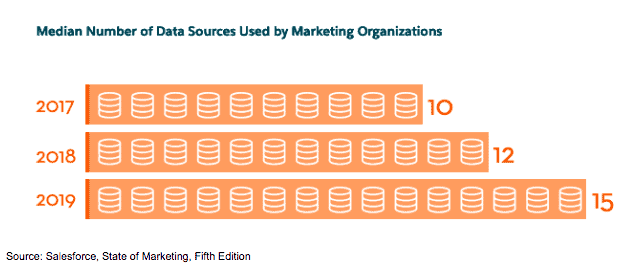

By Michael Clark
Just before the end of 2018, Salesforce released its annual State of Marketing report (fifth edition). I like this bit of research, because it is relatively easy to mentally benchmark your own organization across a number of important trends occupying the minds of marketing executives in many industries around the world. The report’s data is based on surveys of over 4,100 marketing leaders worldwide and then sub-divided by region and industry. As you might imagine, issues around Data and Customer Experience were top of mind for many in marketing toward the end of 2018. What I thought I was especially interesting, however, is how the Use Cases of DMP’s for marketing (Data Management Platforms) have shifted over the past year or so.
DMP Marketing:
A “DMP” or Data Management Platform collects, stores and organizes data from 1st, 2nd and 3rd party data sources with which a marketing agency can model and segment user data to market to with meaningful, impactful, even personalized messaging. DMP Marketing is crucial in an era when the amount of acquired individual data can be collected from many sources and is growing exponentially.
Unsurprisingly, the number of data sources used by marketing organizations have been steadily increasing. Data sources are things such as email systems, website data, call center data (1st-party data), as well as data from partners (2nd-party data) and data purchased from aggregators such as demographic and behavioral data (3rd-party). Salesforce is reporting that the median number of data sources will move from 12 in 2018 to 15 this year.

More does not always equate to better, however. And, with the scrutiny that the Facebook-Cambridge Analytica drama brought to the industry, smart advertisers have been scrutinizing the data that they and their agencies leverage to produce better advertising outcomes. Third-party data, in particular, has been under extensive review. Facebook’s Partner Categories program, for example, which provided the convenience of having Facebook connect third-party data to audiences right within their self-service ad buying tool, became a casualty of the new environment back in October when Facebook ended the program. In addition to questions about the permission-based sources of third-party data, many advertisers have been finding that the data is just not very good.
Marketing Experts Move Towards Utilizing Higher Quality Data
Salesforce’s survey data reflects what you would expect rational marketing executives to do under these circumstances. While they are undoubtedly seeking to connect more first-party data sources to their marketing programs, they are also very much seeking out higher quality second-party sources. Salesforce reports that the number of marketing organizations using second-party data increased in 2018. I would expect this number to grow even further in 2019 as advertisers come to realize that much third-party data is either trash or of questionable origin or both.

How Marketers Plan On Using DATA MANAGEMENT PLATFORMS Moving Forward
This leads us to DMP’s and how marketers have been using them and how they plan to use them in the future. Again, there is a logical progression hidden in plain sight. Historically, DMP’s have been used to execute media buying, manage media delivery (ex. frequency distribution) and to gain deeper analytics about media performance. Salesforce’s survey data reflects this as media related activities occupy the first and third slots in the Top 5 Current DMP Marketing Use Cases. Look what happens, however, when marketing executives are asked how they expect to use their DMP’s in the coming two years. ‘Audience Insights’ and ‘Audience Discovery and Segmentation’ jump to the first and second slots, respectively, and ‘Identity Resolution and Management’ moves up a slot to number 3. Media related Use Cases fall out of the Top 5 entirely. The Top 2 intended uses were not even in 2018’s Top 5 DMP Use Cases.

What is happening here? Well, a few things:
- Advertisers learned an expensive lesson from their rush to Programmatic without really understanding what this technology was built upon. Automating the use of poor data delivers poor results faster and at epic scale. Ask Marc Pritchard.
- Adtech and Martech are converging as organizations struggle with too many sources of “Identity”. It is not uncommon for organizations to have a CRM database in the Sales or Customer Service group, an ESP in the Marketing group, an ERP or other legacy financial recording system controlled by the IT group and probably a media delivery database at their agency. Modern start-up brands do not organize themselves in this manner and have the advantage of a single source of customer identity.
- Smart advertisers are now focused on Audience Planning, rather than just Media Planning. In essence, we have entered a Post Media-Planning Age. Advertisers are finally coming to the realization that in order to drive competitive separation and advantage, they need to own audience definition and the data that informs the building of their audiences. Audience definition is not a process that should be outsourced and the unique data combinations that inform their audiences are a critical strategic asset. DMP’s are essential in a Post Media-Planning age, which will be won by smart and informed Audience Planners.
We are seeing greater separation between advertising winners and losers. The winners know what to pay for audience attention, the losers will remain content with guessing. Knowing what to pay for consumer attention and influence and how best to obtain that attention will rely on the smart application of People, Technology and Process. The technology part, for the near-term, will be the DMP Marketing.
Salesforce also reported that marketers expect their use of DMP’s to increase by 64% by 2020. If you are not one of those marketers, you will be eating dust. It’s no wonder that demand for BCM’s DMP services have increased so dramatically in the past 18 months.
What are you seeing? What are your planned DMP Use Cases over the next 24 months?

The Marketers Guide To First Party Data
First Party Data: The Ultimate Guide for Marketing & Advertising Your company is at risk of losing customers and sales to the competition.


